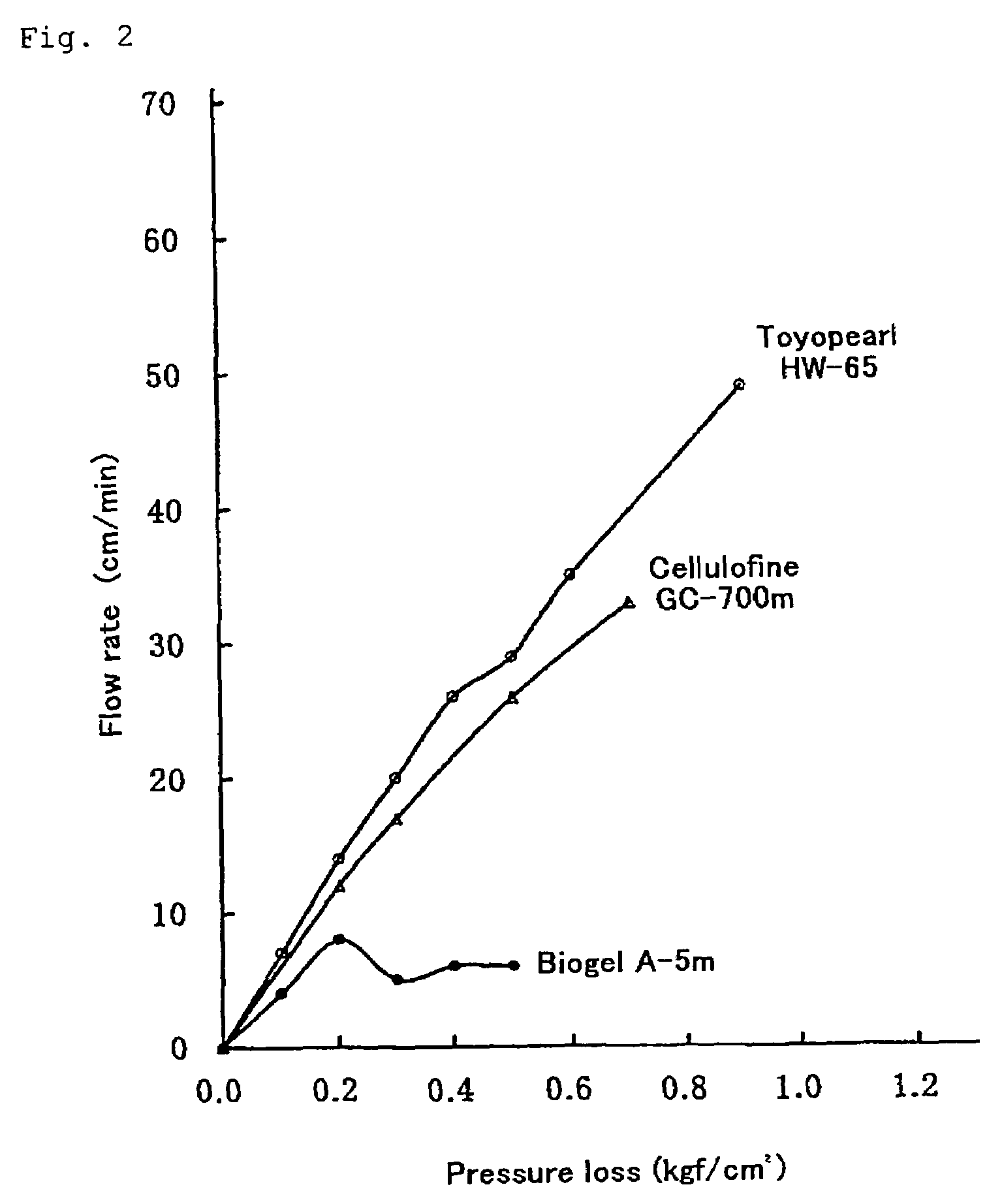Body fluid processor enabling direct hemoperfusion
a body fluid and processor technology, applied in the field of body fluid processors, can solve the problems of difficult direct hemoperfusion, reduced clearance between particles, and difficult technology, and achieve the effects of low risk of generation and leakage, stable manner, and high flow ra
- Summary
- Abstract
- Description
- Claims
- Application Information
AI Technical Summary
Benefits of technology
Problems solved by technology
Method used
Image
Examples
example 1
[0070]To 2000 ml of porous cellulose beads with a mean particle diameter of about 190 μm (product of Chisso Corporation) were added 2000 ml of water, 1060 ml of 2 N aqueous solution of NaOH, and 360 ml of chloromethyloxysilane, and the mixture was stirred at 40° C. for 2 hours. After completion of the reaction, the beads were rinsed thoroughly with water to give epoxy-activated cellulose beads.
[0071]In 630 ml of water was dissolved 930 g of dextran sulfate (product of Meito Sangyo Co., sulfur content ca 18%) to prepare an aqueous solution of dextran sulfate and 2000 ml of the epoxy-activated cellulose beads and 100 ml of water were added to the solution. After the mixture was adjusted to pH 9.5 with an aqueous solution of NaOH, the reaction was carried out at 45° C. for 22 hours. After this reaction, the beads were thoroughly washed with water and aqueous solution of NaCl and following addition of 19.6 ml of 2-aminoethanol, the mixture was allowed to stand at 45° C. for 2 hours to b...
example 2
[0075]Of the particles for processing body fluid prepared in Example 1, 142 ml in sedimentation volume was taken and packed into a vessel similar to the one used in Example 1 to prepare a body fluid processor with a packing ratio of ca 100% and an occupancy ratio of ca 100%. Physiological saline was used as a filling liquid.
[0076]Using 1200 ml of bovine blood (ionized Ca concentration: ca 0.6 mM), which has been subjected to anticoagulation by citric acid, as a blood pool, the blood was circulated through the body fluid processor at a flow rate of 20 ml / min (superficial linear velocity: ca 2.6 cm / min) (the time of circulation start was designated as min-0). As a result, a stabilized passage of the blood cell was obtained over min-O to min-90. During this time the pressure drop of the body fluid processor was stable around 90 mmHg. During the subsequent period of min-90 to min-95, increasing the flow rate to 29 ml / min (superficial linear velocity: ca 3.9 cm / min) resulted in a stable ...
example 3
[0077]Of the particles for processing body fluid prepared in Example 1, 708 ml in sedimentation volume was taken and packed into a 7.0 cm (in. dia.) cylindrical vessel (the volume of packed zone: ca 730 ml) equipped with two 48 μm-apertured polyester meshes rigidly mounted at a mesh-to-mesh distance of 19 cm to prepare a body fluid processor with a packing ratio of ca 97% and an occupancy ratio of ca 100%. Citric acid-sodium citrate buffer (pH=6.0) was used as a filling liquid.
[0078]The body fluid processor was washed with 2000 ml of physiological saline and using 7000 ml of bovine blood (ionized Ca concentration: ca 0.5 mM), which has been subjected to anticoagulation by citric acid, as a blood pool, the blood was circulated through the body fluid processor at a flow rate of 100 ml / min (superficial linear velocity: ca 2.6 cm / min) (the time of circulation start was designated as min-0). As a result, a stabilized passage of the blood cell was obtained over min-O to min-90. During thi...
PUM
| Property | Measurement | Unit |
|---|---|---|
| mean particle diameter | aaaaa | aaaaa |
| size | aaaaa | aaaaa |
| size | aaaaa | aaaaa |
Abstract
Description
Claims
Application Information
 Login to View More
Login to View More - R&D
- Intellectual Property
- Life Sciences
- Materials
- Tech Scout
- Unparalleled Data Quality
- Higher Quality Content
- 60% Fewer Hallucinations
Browse by: Latest US Patents, China's latest patents, Technical Efficacy Thesaurus, Application Domain, Technology Topic, Popular Technical Reports.
© 2025 PatSnap. All rights reserved.Legal|Privacy policy|Modern Slavery Act Transparency Statement|Sitemap|About US| Contact US: help@patsnap.com



